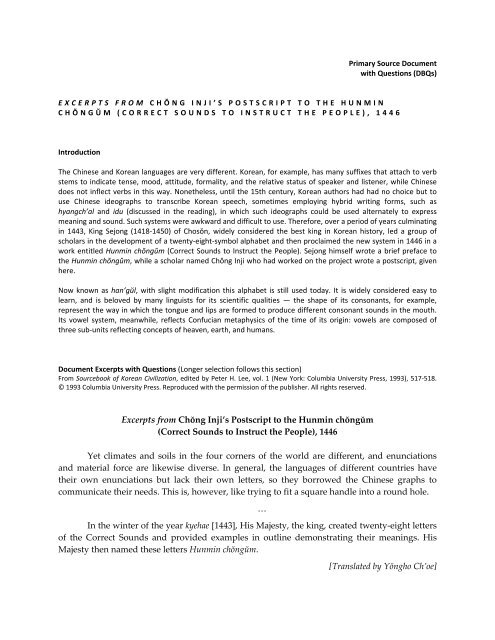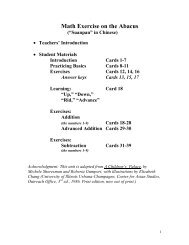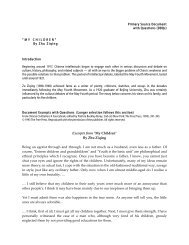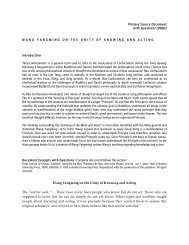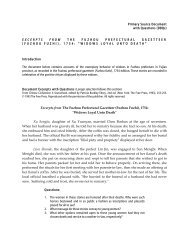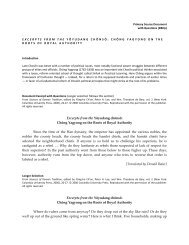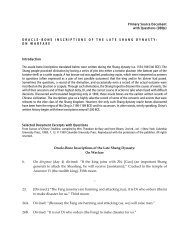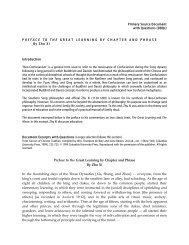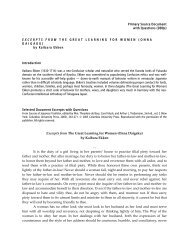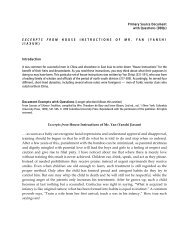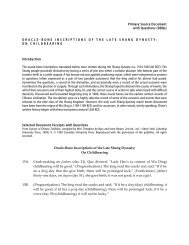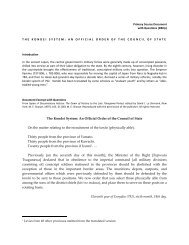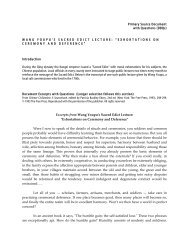Chông Inji's Postscript to the Hunmin Chôngûm - Asia for Educators ...
Chông Inji's Postscript to the Hunmin Chôngûm - Asia for Educators ...
Chông Inji's Postscript to the Hunmin Chôngûm - Asia for Educators ...
You also want an ePaper? Increase the reach of your titles
YUMPU automatically turns print PDFs into web optimized ePapers that Google loves.
PrimarySourceDocumentwithQuestions(DBQs)EXCERPTSFROM CHŎNGINJI’ SPOSTSCRIPTTOTHEHUNMINCHŎNGŬM(CORRECTSOUNDSTOINSTRUCTTHEPEOPLE),1446IntroductionTheChineseandKoreanlanguagesareverydifferent.Korean,<strong>for</strong>example,hasmanysuffixesthatattach<strong>to</strong>verbstems<strong>to</strong>indicatetense,mood,attitude,<strong>for</strong>mality,and<strong>the</strong>relativestatusofspeakerandlistener,whileChinesedoesnotinflectverbsinthisway.None<strong>the</strong>less,until<strong>the</strong>15thcentury,Koreanauthorshadhadnochoicebut<strong>to</strong>use Chinese ideographs <strong>to</strong> transcribe Korean speech, sometimes employing hybrid writing <strong>for</strong>ms, such ashyangch’al and idu (discussed in <strong>the</strong> reading), in which such ideographs could be used alternately <strong>to</strong> expressmeaningandsound.Suchsystemswereawkwardanddifficult<strong>to</strong>use.There<strong>for</strong>e,overaperiodofyearsculminatingin 1443, King Sejong (1418‐1450) of Chosŏn, widely considered <strong>the</strong> best king in Korean his<strong>to</strong>ry, led a group ofscholarsin<strong>the</strong>developmen<strong>to</strong>fatwenty‐eight‐symbolalphabetand<strong>the</strong>nproclaimed<strong>the</strong>newsystemin1446inaworkentitled<strong>Hunmin</strong>chŏngŭm(CorrectSounds<strong>to</strong>Instruct<strong>the</strong>People).Sejonghimselfwroteabriefpreface<strong>to</strong><strong>the</strong><strong>Hunmin</strong>chŏngŭm,whileascholarnamedChŏngInjiwhohadworkedon<strong>the</strong>projectwroteapostscript,givenhere.Nowknownashan’gŭl,withslightmodificationthisalphabetisstillused<strong>to</strong>day.Itiswidelyconsideredeasy<strong>to</strong>learn, and is beloved by many linguists <strong>for</strong> its scientific qualities — <strong>the</strong> shape of its consonants, <strong>for</strong> example,represent<strong>the</strong>wayinwhich<strong>the</strong><strong>to</strong>ngueandlipsare<strong>for</strong>med<strong>to</strong>producedifferentconsonantsoundsin<strong>the</strong>mouth.Its vowel system, meanwhile, reflects Confucian metaphysics of <strong>the</strong> time of its origin: vowels are composed ofthreesub‐unitsreflectingconceptsofheaven,earth,andhumans.DocumentExcerptswithQuestions(Longerselectionfollowsthissection)FromSourcebookofKoreanCivilization,editedbyPeterH.Lee,vol.1(NewYork:ColumbiaUniversityPress,1993),517‐518.©1993ColumbiaUniversityPress.Reproducedwith<strong>the</strong>permissionof<strong>the</strong>publisher.Allrightsreserved.Excerptsfrom ChŏngInji’s<strong>Postscript</strong><strong>to</strong><strong>the</strong><strong>Hunmin</strong>chŏngŭm(CorrectSounds<strong>to</strong>Instruct<strong>the</strong>People),1446Yet climates and soils in <strong>the</strong> four corners of <strong>the</strong> world are different, and enunciationsand material <strong>for</strong>ce are likewise diverse. In general, <strong>the</strong> languages of different countries have<strong>the</strong>ir own enunciations but lack <strong>the</strong>ir own letters, so <strong>the</strong>y borrowed <strong>the</strong> Chinese graphs <strong>to</strong>communicate<strong>the</strong>irneeds.Thisis,however,liketrying<strong>to</strong>fitasquarehandlein<strong>to</strong>aroundhole.In<strong>the</strong>winterof<strong>the</strong>yearkyehae[1443],HisMajesty,<strong>the</strong>king,createdtwenty‐eightlettersof <strong>the</strong> Correct Sounds and provided examples in outline demonstrating <strong>the</strong>ir meanings. HisMajesty<strong>the</strong>nnamed<strong>the</strong>seletters<strong>Hunmin</strong>chŏngŭm.…[TranslatedbyYŏnghoCh’oe]
PrimarySourceDocumentwithQuestions(DBQs)onEXCERPTSFROMCHŎNGINJI’SPOSTSCRIPTTOTHEHUNMINCHŎNGŬM(CORRECTSOUNDSTOINSTRUCTTHEPEOPLE),1446Questions:1. Whateffectsdoyouimagine<strong>the</strong>newalphabetmighthavehad?LongerSelectionFromSourcebookofKoreanCivilization,editedbyPeterH.Lee,vol.1(NewYork:ColumbiaUniversityPress,1993),517‐518.©1993ColumbiaUniversityPress.Reproducedwith<strong>the</strong>permissionof<strong>the</strong>publisher.Allrightsreserved.Excerptsfrom ChŏngInji’s<strong>Postscript</strong><strong>to</strong><strong>the</strong><strong>Hunmin</strong>chŏngŭm(CorrectSounds<strong>to</strong>Instruct<strong>the</strong>People),1446Justas<strong>the</strong>reareenunciationsthatarenatural<strong>to</strong>heavenandearth,<strong>the</strong>remustalsobewritingthatisnatural<strong>to</strong>heavenandearth.Itis<strong>for</strong>thisreasonthat<strong>the</strong>ancientsdevisedletterscorresponding<strong>to</strong>enunciationssoas<strong>to</strong>convey<strong>the</strong>situationsandsentimentsofmyriadthingsand <strong>to</strong> record <strong>the</strong> ways of heaven, earth, and men so that <strong>the</strong>y cannot be changed by latergenerations.Yet climates and soils in <strong>the</strong> four corners of <strong>the</strong> world are different, and enunciationsand material <strong>for</strong>ce are likewise diverse. In general, <strong>the</strong> languages of different countries have<strong>the</strong>ir own enunciations but lack <strong>the</strong>ir own letters, so <strong>the</strong>y borrowed <strong>the</strong> Chinese graphs <strong>to</strong>communicate<strong>the</strong>irneeds.Thisis,however,liketrying<strong>to</strong>fitasquarehandlein<strong>to</strong>aroundhole.Howcoulditpossiblyachieveitsobjectivesatisfac<strong>to</strong>rily?Howcould<strong>the</strong>renotbedifficulties?Itis,<strong>the</strong>re<strong>for</strong>e,importantthateachregionshouldfollow<strong>the</strong>practicesthatareconvenient<strong>to</strong>itspeopleandthatnooneshouldbecompelled<strong>to</strong>followonewritingsystemalone.Althoughourcountry’srituals,music,andliteraturearecomparable<strong>to</strong>thoseofChina,ourspeechandlanguagearenot<strong>the</strong>sameasChina’s.ThosewhostudiedbooksinChinesewereconcerned about <strong>the</strong> difficulty of understanding <strong>the</strong>ir meaning and purport; those whoadministered<strong>the</strong>penalsystemweretroubledby<strong>the</strong>difficultyincommunicating<strong>the</strong>complexityofitslegaltexts.In<strong>the</strong>olddays,SŏlCh’ong[c.660‐730]ofSillafirstdevised<strong>the</strong>writingsystemknowasidu,whichhasbeenusedbyourgovernmentandpeople<strong>to</strong>thisday.Butall<strong>the</strong>graphswereborrowedfromChinese,andfrequently<strong>the</strong>reariseproblemsanddifficulties.No<strong>to</strong>nlyisidu vulgar and baseless, but as a means of linguistic communication, it cannot transmit onemeaningintenthousandcases.In<strong>the</strong>winterof<strong>the</strong>yearkyehae[1443],HisMajesty,<strong>the</strong>king,createdtwenty‐eightlettersof <strong>the</strong> Correct Sounds and provided examples in outline demonstrating <strong>the</strong>ir meanings. HisMajesty <strong>the</strong>n named <strong>the</strong>se letters <strong>Hunmin</strong> chŏngŭm. Resembling pic<strong>to</strong>graphs, <strong>the</strong>se lettersimitate<strong>the</strong>shapesof<strong>the</strong>oldsealcharacters.Basedonenunciation,<strong>the</strong>irsoundscorrespond<strong>to</strong><strong>the</strong>SevenModesinmusic.Theselettersembrace<strong>the</strong>principlesofheaven,earth,andmenas<strong>Asia</strong><strong>for</strong>Educa<strong>to</strong>rslColumbiaUniversitylhttp://afe.easia.columbia.eduPage2of3
PrimarySourceDocumentwithQuestions(DBQs)onEXCERPTSFROMCHŎNGINJI’SPOSTSCRIPTTOTHEHUNMINCHŎNGŬM(CORRECTSOUNDSTOINSTRUCTTHEPEOPLE),1446well as <strong>the</strong> mysteries of yin and yang, and <strong>the</strong>re is nothing <strong>the</strong>y cannot express. With <strong>the</strong>setwenty‐eight letters, infinite turns and changes may be explained; <strong>the</strong>y are simple and yetcontainall<strong>the</strong>essence;<strong>the</strong>yarerefinedandyeteasilycommunicable.There<strong>for</strong>e,aclevermancanlearn<strong>the</strong>minonemorning,thoughadullmanmaytaketendays<strong>to</strong>study<strong>the</strong>m.Ifweuse<strong>the</strong>seletters<strong>to</strong>explainbooks,itwillbeeasier<strong>to</strong>comprehend<strong>the</strong>irmeanings.Ifweuse<strong>the</strong>selettersinadministeringrhymes,onecaneasilydistinguishvoicedandvoicelessconsonants;as<strong>for</strong>musicandsongs,twelvesemi<strong>to</strong>nescanbeeasilyblended.Theycanbeusedwhateverandwherever <strong>the</strong> occasion may be. Even <strong>the</strong> sounds of wind, <strong>the</strong> cries of cranes, <strong>the</strong> crowing ofroosters,and<strong>the</strong>barkingofdogscanallbetranscribedinwriting.Consequently, we were commanded <strong>to</strong> provide more detailed explanations <strong>for</strong> all <strong>the</strong>people <strong>to</strong> understand. This servant, <strong>the</strong>re<strong>for</strong>e, along with his o<strong>the</strong>r ministers — Ch’oe Hang,Fourth Grade official; Pak P’aengnyŏn, Junior Fifth Grade official; Sin Sukchu, Junior FifthGradeofficial;SŏngSammun,SixthGradeofficial,allin<strong>the</strong>hallofWorthies;KangHŭian,SixthGradeofficialin<strong>the</strong>RoyalHouseAdministration;YiKae,actingJuniorFourthGradeofficial;andYiSŏllo,actingJuniorFourthGradeofficialin<strong>the</strong>HallofWorthies—havepreparedall<strong>the</strong>explanationsandvariousexamples<strong>to</strong>illustrate<strong>the</strong>generaloutlineof<strong>the</strong>newwritingsystemsothatanyreadercanlearnitwithoutateacher.Thesubtletyofitsprofoundsourcesanddeepmeanings,however,isbeyond<strong>the</strong>scopeofourability<strong>to</strong>demonstratefully.As we humbly reflect, our king, being a heaven‐endowed sage, has instituted varioussystems and institutions that excel those established by a hundred o<strong>the</strong>r kings. As <strong>for</strong> <strong>the</strong>makingof<strong>the</strong>CorrectSounds,itisnotsomethingthathasbeentransmittedfromourances<strong>to</strong>rsbuthasbeenachievedbynature.Thereisnothingin<strong>the</strong>CorrectSoundsthatisnotbasedon<strong>the</strong>ultimateprinciple;<strong>the</strong>reisnobiassuchasonefindsin<strong>the</strong>thingsmadebymen.Althoughourcountryhasexistedin<strong>the</strong>easterncornerof<strong>the</strong>world<strong>for</strong>alongperiodoftime,notuntil<strong>to</strong>dayhas<strong>the</strong>greatwisdomofcultivatinganewenlightenmentandcompletingitstaskbeenrealized.Questions:1. Whateffectsdoyouimagine<strong>the</strong>newalphabetmighthavehad?2. WhydoesChǒngadvocate<strong>the</strong>newalphabe<strong>to</strong>verChineseoridu?3. How does he justify it philosophically? Does he simply present it as apracticalinnovation?4. WhatdoyouthinkwashisoverallviewofChosǒn’srelationship<strong>to</strong>China?[TranslatedbyYŏnghoCh’oe]<strong>Asia</strong><strong>for</strong>Educa<strong>to</strong>rslColumbiaUniversitylhttp://afe.easia.columbia.eduPage3of3


